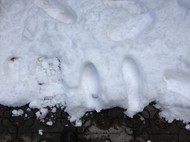Kwaymullina heads to China

Ambelin Kwaymullina travelled to the Australian Writers’ Week in China where she was on hand for the launch of the simplified Chinese editions of her picture books; Crow and the Waterhole , The Two-Hearted Numbat , How Frogmouth Found Her Home and Caterpillar and Butterfly .
China! Four flights (there and back), two cities (Beijing and Tianjin), and ten days of talks, readings and workshops at schools, universities, libraries, and a bunch of other events. This is Australian Writers’ Week in China.
I knew before I went that China was a big place – but as a fact, not as an experience. I found myself pointing out that I was from Perth with embarrassing regularity – you don’t need to catch a train to get across the airport to your baggage in Perth! There’s no buildings this big in Perth! There’s no snow in Perth! And yes, it snowed. Having never seen the stuff before, I tore out of my hotel to pick some of it up, just to see what snow felt like, and instantly felt very Australian (cold, isn’t it?). I started to carry around a mental image of myself as a small kangaroo, taken out of a familiar world of eucalypts and creeks to stare wide-eyed and bewildered at the strange sights in the land of pandas, monkeys and tigers.
The theme for Australian Writers’ Week this year was children’s literature, which meant I was in China with a group of very talented Aussies involved in children’s and young adult writing and illustration – Meredith Badger, Ann Haddon, Ann James, Alison Lester, Pam Macintyre, Rob Newton, and Anne Spudvilas. We came from different backgrounds and different parts of Australia, and between us all we represented a massively diverse range of commentary, novels, picture books, and art. But what we had in common – aside from being Aussies out in the big wide world! – was a dedication to, and respect for, children and teenagers. I paraphrased author Mem Fox a few times in China, who once said that children deserve the best words – ‘the best words in the best places, and the best characters in the best stories.’ To that we would each have added that children (and teenagers) deserve the best art, the best education, the best opportunities, the absolute best we have to give. And then they deserve that we get up and try to do even better than that on the next book, picture, project …
As a writer I’m used to being able to communicate easily. Within hours of arriving I was wishing I knew even a little of the language; it was a frustrating and unnerving experience to be surrounded by words that I didn’t understand. I thought of my Aboriginal ancestors, herded into missions and reserves and talked at in a language not their own. I thought, too, of the refugees who flee in terror across vast distances into unfamiliar lands, and was humbled by the courage of people who daily deal with strange words, and worlds.
What stayed with me the most out of the whole trip was the universality of the young. I needed no translator to tell me when a child thought they’d said something especially clever or outrageous; when they were having a laugh at my expense; or when they were transfixed by a piece of artwork. And the bright inquisitiveness of teenagers and of university students, their hunger for knowledge – these things, too, did not need to be put into English to be communicated.
It seems to me that we have a wonderful diversity of cultures on this planet, and we have also something which connects us all – this next generation of bright eyes and bright minds. They surely deserve the best of us, the best earth that we can leave to them. I don’t think we’ve achieved that yet. I don’t think we’re even close.
Maybe it’s time to get up, and try again.


